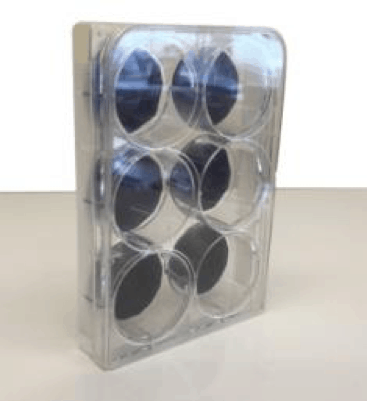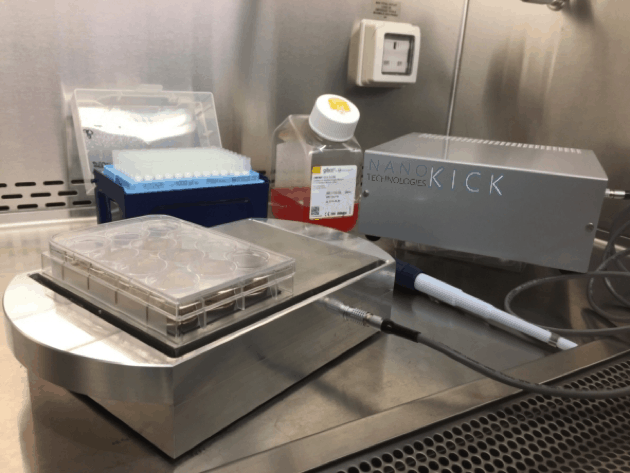CeMi paper – Nanokicking stem cells to grow new bone – Nat. Biomed. Eng. 1, p 758–770 (2017)
This is a presentation post on the paper Tsimbouri, Childs et al. Stimulation of 3D osteogenesis by mesenchymal stem cells using a nanovibrational bioreactor. Nat. Biomed. Eng. 1, p 758–770 (2017).
doi: 10.1038/s41551-017-0127-4
By Dr Monica P. Tsimbouri.
People live longer but our body parts cannot keep up, we need new therapies for a better quality of life for our ageing population. This is particularly true for bone repair as better therapeutics are needed for age related fractures including spinal traumas, osteoporosis and stress fractures. This attracted physicists and cell engineers in Glasgow to develop a new technique that is cheaper and easier to implement than current technologies. That technique is Nanokicking stem cells to grow new bone.
This work brought together cell engineers, Professor Adam Curtis, Professor Matthew Dalby and Dr Monica P Tsimbouri (myself) at the University of Glasgow, and physicists, Professor Reid and Dr Peter Childs, both at the time at the University of West of Scotland.
The Idea
The late Emeritus Professor Adam Curtis observed that cells seem to “tiptoe” across surfaces and wondered what would happen if you vibrated the surface back at the cells. This inspired the idea of using nanovibrations in the lab.
The cells used in work are stem cells. Stem cells can be stimulated to change into different cell types such as bone, cartilage, ligament, tendon and muscle. In the lab, this stimulation is typically done by using complex and expensive engineering or cocktails of chemicals. Using nanovibrations to direct stem cell behaviour to generate bone cells doesn’t require dangerous or expensive tools. Nanovibrations are naturally experienced by our organs as we breathe, walk and move. Stem cells respond to these unique vibrations to regenerate damaged tissue. These vibrations have specific frequencies unique for different tissues and are measured in hertz (Hz) e.g. for bone around 970Hz.
Nanokicking makes use of the fact that during the bone healing process the individual cell membranes vibrate as they adhere. By vibrating the stem cells at the bone’s unique frequency stimulates the cell interaction and promotes bone formation. We can replicate this vibration by ‘kicking’ the stem cells in the lab using our Nanokicking bioreactor around 5-30 nanometres vertically at 1,000 Hz (1,000 times per second).
Dr Childs (Peter, the physicist of the team) developed the current form of the bioreactor. Peter fine-tuned the strength and frequency of the nanokicks using laser interferometry which amongst other things is used to detect tiny ripples in space-time caused by gravitational waves!

Magnetic attachment of standard format culture plates/flasks. The systems is compatible with 3D scaffold materials (e.g. collagen).
Myself, the cell biologist, with some help from my friends at the CCE (Gabriel, Jingli, Wich, Vineetha) nanovibrated stem cells from the bone marrow into bone-making cells on a large scale without the use of cocktails of chemicals or challenging and complex equipment. I used collagen as my scaffold, to study and analyse the effects of nanovibrations on stem cell phenotype in 3D. I found increased expression of osteogenic genes and proteins in the nanokicked gels with stem cells. Even more, mineral crystals were formed indicating the early changes towards bone development.
The use of collagen in this 3D study provided mechanical integration through its direct interaction with the plastic 6-well plate walls. Hence, we don’t need to use dense osteogenic scaffolds, e.g. calcium phosphates which have some limitations. In addition, the collagen gel is very soft with no osteogenic effects.
The challenges
Our team is multidisciplinary and this brings a lot of challenges as researchers need to learn new scientific languages. This collaboration between cell biologists and astrophysicists has yielded new insights as to how bone stem cells work, how they respond to nanovibrations previously at 2D and now at 3D level with the potential of developing bone grafts for translational therapies. We can generate 60 ml of mineralizing osteoblasts in an appropriate 3D matrix gel from stem cells on a single bioreactor!
The Find a Better Way project
At the start of 2017 our team received funding from Find a Better Way, a charity funded by Sir Bobby Charlton to develop technologies that can help landmine and blast injury survivors. In this project we are now working with clinicians (Prof Andrew Hart, Prof Dominic Meek, Royal Navy Captain Rory Rickard) to tackle the challenges of translating the Nanokicking technology to better bone therapeutics. In this project we plan to run a first-in-human trial of the technology for the reconstruction of complex fractures of fingers of the hand, and we will test pre-clinically the combination of nanokicked cells with the use of a functional polymer coating technology also developed by CeMi researchers, to advance in the development of bone grafts for larger bone defects.

